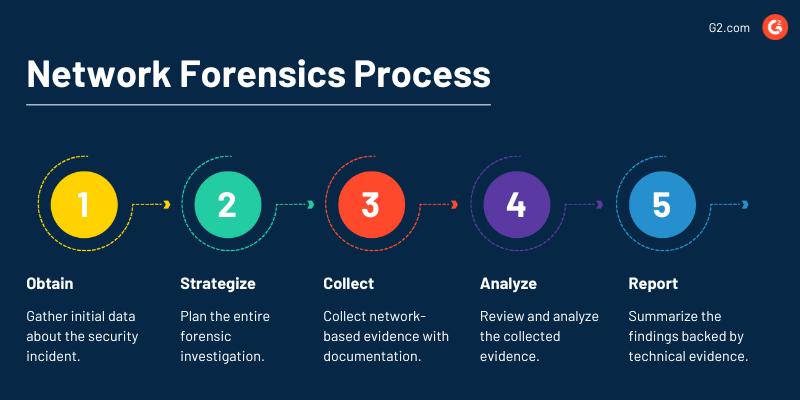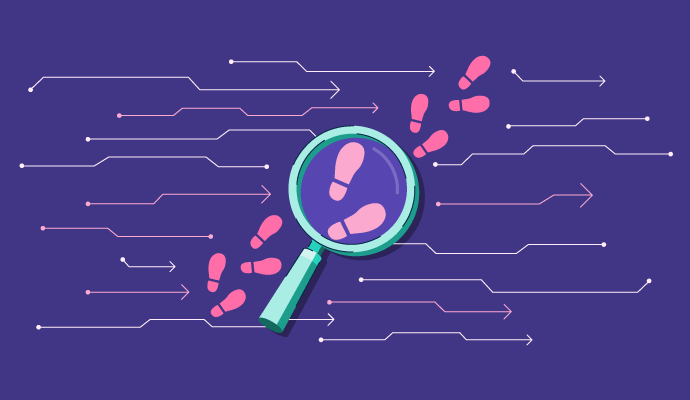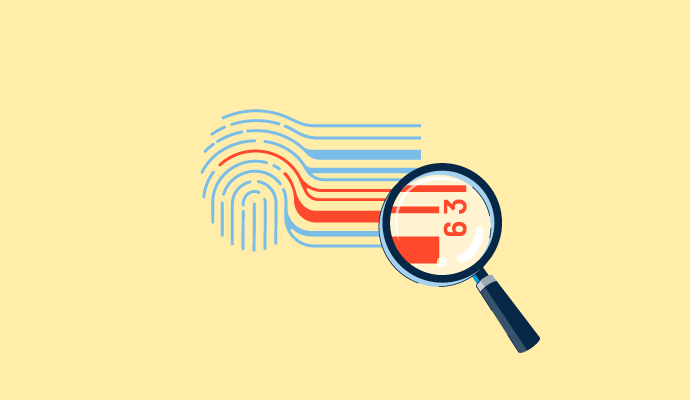Forensics is such a hot skill, and thanks to numerous crime shows, I’m convinced it’s easy work. Maybe you can relate?
We all know the reality is – quite different – especially when we step into the world of digital investigations.
Traditional forensic science adeptly investigates and analyzes physical evidence in the realm of crimes and incidents, but digital forensics is like finding a needle in the haystack. Uncovering evidence and insights requires a specialized set of tools and techniques. Network forensics, the science of investigating the activity throughout the vast interconnected webs of networks, came into being to fulfill those requirements.
What is network forensics?
Network forensics is a branch of digital or computer forensics. It monitors and analyzes network traffic, events, logs, and communication patterns after cybersecurity incidents to gather information, secure legal evidence, and pinpoint intrusion.
Digital forensics experts rely on network forensic to reconstruct events, understand the intention, and set preventive measures in motion to avoid future incidents. Solutions like digital forensics software and network traffic analysis (NTA) tools for network forensics investigation make the work easier.
The importance of network forensics
Recently, a former Apple employee was found guilty of stealing the iPhone maker’s trade secrets days before his resignation from the company. How’d he get caught?? His computer network activity snitched.
Multiple security tools protect against cyberattacks. But once an attack or security incident has already happened, all you can do is improve your incident response and mitigation strategies.
You have to conduct a root cause analysis of the attacks, find out whether the security incident is under control or not, and if you’ve found all systems affected by the attack. Remember: cyberattacks today affect multiple devices across a network.
Post-attack, computer or digital forensics gathers all the electronic evidence of the security incident. It focuses on data recovery and filesystem analysis. However, the hard drive reveals only a tiny piece of the story in the internet world today. Computer forensics is just not enough because hackers might be able to erase all log files on a compromised host.
The only evidence available for forensic analysis might be on the network, and if that’s the case, network forensics is what helps the most. After all, networks are the fundamental means of exchange of information and communication for every individual, enterprise, and organization.
$2.2 billion
is the estimated revenue of the global network forensics market by 2027.
Source: Markets and Markets
Network forensics investigates all kinds of attacks by analyzing incoming and outgoing traffic patterns. It recovers every transaction—emails, instant messages, file transfers—and reconstructs the exchange. This information leads to the source of the attack. Investigators can then piece together a complete picture of the cybersecurity incident using network-based evidence.
Network forensics is particularly helpful when the attack is in progress, and you don’t want to tip off the hackers that you are on their trail.
Who uses network forensics?
Organizations that use network forensics tools for traffic and data analysis include:
- Law enforcement
- Military and government agencies
- Businesses and enterprises
- Academia and research organizations
- Cybersecurity companies
Möchten Sie mehr über Digitale Forensik-Software erfahren? Erkunden Sie Digitale Forensik Produkte.
Computer and network forensics
By now, you might be starting to understand that computer forensics is different from network forensics. But here’s a quick rundown to make sure you’re up to speed.
Digital or computer forensics involves investigating and analyzing data at rest. It involves meticulous examination and analysis of digital devices to aid in investigations ranging from cyberbullying to data breaches.
Network forensics is a branch of computer forensics that investigates data in motion and deals with volatile and dynamic information. It plays a crucial role in helping us understand the interactions and activities that occur between devices across a network.
Key applications of network forensics
From strengthening cybersecurity posture to gathering digital evidence, here’s how different organizations use network forensics.
- Cybersecurity operations: Network forensics helps security teams respond effectively to mitigate threats caused by intrusions, malware, or unauthorized access.
- Incident response: Incident response teams apply network forensics to understand the scope, impact, and entry points of attacks. Their work facilitates swift containment and recovery in real time.
- Legal investigations: Law enforcement agencies and private investigators use network forensics to analyze network activities and communication patterns in cases involving cybercrime, data breaches, and online fraud.
- Insider threat detection: By monitoring network activity for unusual or unauthorized actions by employees or contractors, network forensics identifies insider threats.
- Network performance optimization: Beyond security, network administrators can use network forensics to analyze performance issues, identify bottlenecks, and optimize data transmission.
- Research and development: Researchers explore network forensics investigations to advance their techniques for detecting and preventing cyber threats. This contributes to the evolving landscape of cybersecurity solutions.
- From the use cases, you can see network forensics is an extension of network security, which traditionally emphasizes the detection and prevention of network attacks.
How does network forensics work
Severe cyberattacks like ransomware or supply chain attacks often start from one instance of unauthorized entry into the targeted system. From that single entry point, hackers move in and out of the system through different devices like routers, firewalls, hubs, and switches. Network forensics identifies and analyzes all this network-based evidence to understand what happened.
Network forensics process
The five key steps to the network forensics investigation are:
- Obtain
- Strategize
- Collect
- Analyze
- Report
Or OSCAR. This framework, also used in digital forensics, assures accurate and meaningful results.

1. Obtain information
Network forensic investigators gather initial information about the incident and network environment in question. This includes details on the date and time of the incident, people, systems, and endpoints involved, along with actions taken. This data shows them crucial details about the incident.
2. Strategize
This step involves planning the entire forensic investigation as network data is volatile and differ in their nature. Professionals keep the following points in mind while developing their process:
- Goals of the investigation
- Timeline
- Source and strength of evidence
- Resources and personnel needed
- Time of updates
Strategizing helps decide the direction of the investigation and prioritize which evidence needs to be collected first.
3. Collect evidence
Collecting evidence includes documenting all the systems that are accessed and used, capturing and saving network data streams to hard drives, and gathering logs from firewalls and servers. The documentation has to include time, source of the evidence, acquisition method, and the investigators involved.
Sources for network forensics analysis
Conducting an investigation often requires collecting evidence from various sources to understand what transpired. Here are some common sources where you may find network data during an investigation:
- Network traffic data comprises the information exchanged between network devices. Tools like packet capturing solutions, packet sniffers, or network monitoring systems record the data.
- Logs from routers and switches track communication between network segments.
- Proxy network server logs monitor user requests and responses to provide details about accessed websites, times of access, and user activities.
- Firewall logs record attempted connections, allowed or denied traffic, and rule violations.
- Intrusion detection and prevention systems (IDPS) alerts are generated when they detect suspicious or malicious activities.
- Domain name system (DNS) logs contain domain queries, internet protocol (IP) addresses, and websites accessed by users.
- Email server logs save data about incoming and outgoing email traffic, including sender and recipient addresses and timestamps.
- Authentication logs maintain records of successful and failed login attempts to help trace user activities and potential unauthorized access.
- Server logs from databases, applications, and web servers provide information about user requests, transactions, and activities.
- Wireless access point logs document wireless devices that connect to the network. This action is part of wireless forensics, a branch of network forensics.
4. Analyze evidence
This core phase reviews the evidence using multiple manual and automated forensics techniques to correlate datasets from different network devices. The analysis typically starts with some initial leads like:
- Alerts from intrusion detection systems
- Noticeable patterns that show signs of attacks like denial of service or virus infiltration
- Log anomalies
- Any deviations from baselines of normal network behavior like unusual traffic patterns or unexpected network protocols or port errors, or other abnormal network behavior
Correlating all this data establishes a timeline of events and develops working theories about how the attack occurred. Analysis may lead to further collection of evidence from additional sources.
5. Reporting
The network forensics investigators summarize their findings based on the technical evidence they collected and analyzed. The report should be simple for even laypeople to understand.
Network data collection methods in network forensics
Network data collection is a fundamental step in the network forensics process. Collection happens through two methods.
1. Catch it as you can method
The "catch it as you can" approach captures and analyzes network traffic as it traverses through a particular point in the network all at once, i.e., in batch mode. This method requires a large amount of storage to match the amount of data coming in for analysis.
2. Stop-look-listen method
In this approach, network packets are rudimentarily analyzed in memory, and only select network data deemed worthy of further analysis is recorded. As a result, not as much storage is needed.
Best practices to follow while collecting network-based evidence
- Minimize interactions with the network to prevent altering evidence.
- Collect data passively whenever possible and avoid making changes that could affect ongoing activities.
- Use industry-standard tools for evidence collection to guarantee accuracy.
- Make copies of all the evidence and generate cryptographic hashes for its verification.
- Work on copies of evidence instead of the original.
- Maintain a chain of custody by documenting all steps of evidence handling.
Challenges in network forensics
The initial and most crucial challenge with network forensics revolves around preparing the infrastructure for investigation. It should ensure that the required data exists for a full investigation. However, it is no easy task, and investigators deal with numerous challenges while carrying out their work.
- Data volume and storage: Since networks generate vast amounts of data, storing and managing poses issues. Efficient storage solutions are necessary to retain relevant data for analysis while avoiding overwhelming storage capacities.
- Encryption: Internet connections are often protected with transport layer security (TLS) and secure socket layer (SSL) encryptions. While encryption is beneficial for protecting data, from a digital forensics standpoint, encrypted traffic makes analysis without decryption keys difficult.
- Data integrity: You cannot compromise when it comes to the integrity of collected data. If someone tampers with or corrupts the collected data, the outcome of the network forensic analysis could be adversely affected.
- Privacy concerns: Striking a balance between conducting effective forensics and respecting user privacy gets complicated when collected data includes private or sensitive information. The situation calls for proper handling and strong access control measures.
- Resource constraints: Dealing with limited resources is a big challenge in network forensics as it requires a lot of people, computer power, and time to aggregate and analyze data from different sources.
Network forensics tools
Employ the right set of network forensics tools to mitigate the mentioned challenges. These five software tools cover various aspects of network infrastructure and help with the forensics process.
1. Network traffic analysis software
Modern NTA tools focus on analyzing network traffic patterns and packets flowing by collecting and analyzing data like the source and destination IP addresses, ports, traffic protocols, and traffic volume. IT and security teams use it to identify network security threats, monitor data flow, and conduct forensic investigations.
Top 5 NTA tools
- IBM Security QRadar SIEM
- Check Point Next Generation Firewalls (NGFWs)
- Progress WhatsUp Gold
- Arista NDR
- FortiAnalyzer
2. Network monitoring software
Network monitoring software shows you your entire network and handles different aspects of network components, devices, and traffic. While network monitoring tools are primarily used for real-time tracking, analysis, and optimization of network activities, they also generate a wealth of value for forensic investigations after security incidents or breaches.
Top 5 network monitoring software platforms
* Above are the five leading network monitoring solutions from G2’s Fall 2024 Grid® Report.3. IDPS
Intrusion detection and prevention software is an important component of network forensics and security. IDPS can help detect and prevent unauthorized access to networks and systems. It works by analyzing network packets, system logs, and other data sources to identify signs of malicious activities or policy violations.
Top 5 IDPS solutions
- Palo Alto Networks Threat Prevention
- Palo Alto Networks Next-Generation Firewall
- Hybrid Cloud Security
- Blumira Automated Detection & Response
- AlienVault USM (from AT&T Cybersecurity)
* Above are the five leading IDPS solutions from G2’s Fall 2024 Grid® Report.
4. Digital forensic software
Digital forensics software is designed to gather, analyze, and interpret digital evidence from computers, mobile devices, storage media, and networks. While its primary focus lies with the analysis of digital artifacts, it also plays a role in network forensics.
Note the specialized network-related forensics tools mentioned here offer more advanced features tailored for network forensics investigations.
Top 5 digital forensics software
- IBM Security QRadar SIEM
- Belkasoft
- Microsoft Purview Audit
- Magnet Forensics
- SentinelOne Singularity RemoteOps Forensics
* Above are the five leading digital forensics solutions from G2’s Fall 2024 Grid® Report.
5. Security information and event management (SIEM) systems
SIEM systems provide centralized visibility, event correlation, and advanced analytics capabilities. They help organizations investigate and respond to potential vulnerabilities and security incidents. Many SIEM solutions integrate with other network forensics tools to offer comprehensive security and investigation capabilities.
Top 5 SIEM solutions
- Microsoft Sentinel
- IBM Security QRadar SIEM
- Splunk Enterprise Security
- Splunk Enterprise
- AlienVault USM (from AT&T Cybersecurity)
* Above are the five leading SIEM solutions from G2’s Fall 2024 Grid® Report.
The tools mentioned here, like NTA software, digital forensics platforms, IDPS, and SIEM solutions, offer unique capabilities that complement each other within a comprehensive network forensics investigation. Consider your organization’s needs, goals, and resources to decide which combination of tools best suits your investigation strategy.
"Take into consideration that different tools will collect and analyze different types and sizes of artifacts. Depending on how much data you can afford to store and what you can analyze at scale, you could prefer to run tools to store full packet captures, only segments of network connections, or only network metadata," says Giorgio Perticone, the consulting analyst for threat detection and response at Vectra AI.
"This decision can drastically change your forensics capabilities and should be carefully determined upfront,” adds Perticone.
Network forensics career
As the importance of network forensics grows, so does the demand for cybersecurity and IT professionals skilled in the subject from large enterprises, law enforcement agencies, and cybersecurity firms.
A quick search on LinkedIn for “network forensics” careers returns thousands of jobs in the United States alone, going by titles like:
- Computer network defense analyst
- Digital network exploitation analyst
- Cyber response investigator
- Investigation and forensic analyst
- Threat intelligence analyst
- Security analyst
Security and network analysts need at least a bachelor's degree in computer science, cybersecurity, or a related field. Network analysts also need to be proficient in network protocols and traffic analysis and comfortable with tools like packet analyzers and log analysis software.
Ready for the hunt?
Any organization considering digital forensics as part of its security posture should embrace the powerful branch of network forensics to fortify its defenses. By doing this, organizations can stay one step ahead in the ongoing battle against evolving cyber threats.
Curious to learn more? Dive into this article on network traffic analysis and how it strengthens network security.
This article was originally published in 2023. It has been updated with new information.

Soundarya Jayaraman
Soundarya Jayaraman is a Content Marketing Specialist at G2, focusing on cybersecurity. Formerly a reporter, Soundarya now covers the evolving cybersecurity landscape, how it affects businesses and individuals, and how technology can help. You can find her extensive writings on cloud security and zero-day attacks. When not writing, you can find her painting or reading.

.png)

